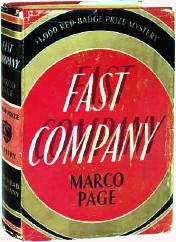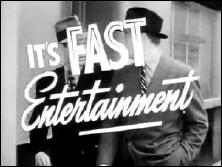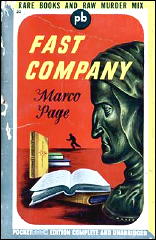Fri 24 Jul 2009
MARCO PAGE – Fast Company. Dodd Mead, hardcover, March 1938. Pocket #222, paperback; 1st printing, July 1943; Paperback Library 52-192, ca.1962. Film: MGM, 1938 (scw: Marco Page, Harold Tarshis; dir: Edward Buzzell).

Marco Page, a pseudonym of Harry Kurnitz, 1909-1968, wrote or co-wrote 33 screenplays for Hollywood movies between 1938 and 1966. He wrote or adapted four plays for the stage between 1954 and 1963.
More importantly for the purposes of this review, he wrote four mystery/detective novels between 1938 and 1955. Fast Company was the first of these.
Of his screen work, Shadow of the Thin Man (1941) and The Thin Man Goes Home (1945) are the most telling of his style, because Page’s detecting couple in Fast Company is obviously based upon Nick and Nora Charles from Hammett’s novel The Thin Man (1934).
The plot of Fast Company revolves around some dirty business going on in New York’s rare book trade. A frame-up and an elaborate scheme for stealing, altering and re-selling valuable books are the main plot-drivers in this fast-paced mystery.
Rare book dealer Joel Glass (with help from his wife, Garda) discovers that working for insurance companies recovering valuable stolen books is more remunerative than depression era bookselling. The characters make prodigious amounts of wisecracks and drink prodigious amounts of liquor before the story is concluded.

One would not think that so much gunplay, knife-throwing, fist-fighting, kidnapping, head-conking, pistol-whipping, book stealing and fem-fataling was going on in the 1930’s New York rare book milieu!
The best way that I can describe Page’s recipe is as follows: Combine one part Hammett’s Nick and Nora with one part screwball comedy with one part thriller-ish action and then add a tiny dash of fair-play clueing.
One plot point that really annoyed me was that, one day after a character is shot in the shoulder, he manages to free himself from being tied up, beats up a crook and jumps out of a second story window. It’s almost as if Page forgot that the character had been shot.
To be fair to Page, the general consensus of Catalogue of Crime and Twentieth Century Crime and Mystery Writers is that Fast Company is probably the weakest of his four mystery novels.

Still, it was good enough to win Dodd Mead’s second Red Badge Prize Mystery award and got him to Hollywood where three movies were made based on the lead characters of Fast Company.
Page/Kurnitz’s three other mystery novels are:
The Shadowing Third (1946), in which NYC lawyer, David Calder, searches for a stolen priceless violin.
Reclining Figure (1952), in which NYC art dealer, Ellis Blaise, investigates modern art forgeries in California.
Invasion of Privacy (as Harry Kurnitz, 1955), wherein movie studio rep Mike Zorin troubleshoots for his employers.
I have not read any of Page’s other work, but I’ll be on the lookout for his books just to see if he really did improve on his first effort.
Note: A very good review of Fast Company written on 05/09/08 by “prettysinister” on the LibraryThing website indicates that it was one of the earliest American bibliomystery novels. This doesn’t seem to be correct information. I will have to research further.
Coming soon: Another view of this book, taken from 1001 Midnights.
July 24th, 2009 at 7:36 pm
Reclining Figure is probably the best to the Page titles, though I like Fast Company more than you did despite it’s weaknesses. Still, give Reclining Figure a chance, it’s a pretty good read with The Shadowy Third right behind it.
And really, you know bullets and gun butts bounce off the hard boiled heroes of this era like they were Clark Kent. And to be honest, most of those thumps on the head Philip Marlowe took would have put him in the hospital for a week and probably caused a debilitating stroke. We can’t take this stuff too seriously in that regard. After all Watson couldn’t even remember if his wound was in the shoulder or the leg.
They were made of tougher material then I guess.